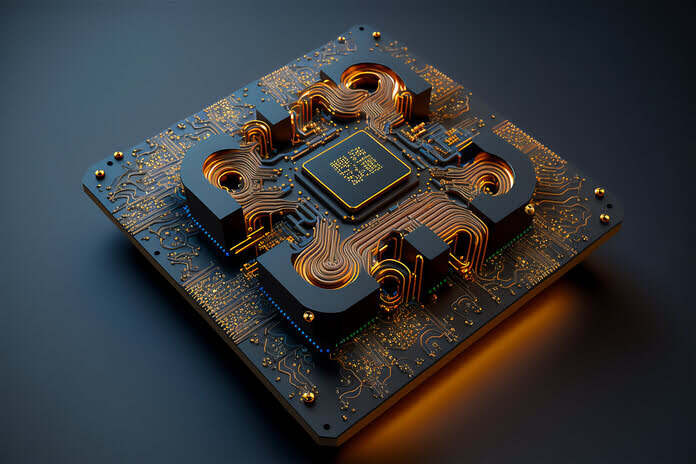Nvidia Stock (NASDAQ:NVDA)
Nvidia (NASDAQ:NVDA) is widely acknowledged as the market leader in AI semiconductor technology. Aside from the company’s strong position in chips/AI hardware, Nvidia is gradually garnering notoriety for its software products, which are still in the early phases of growth and acceptance but, according to company projections, may generate a $300 billion TAM by 2030.
Aside from Nvidia’s vGPU and GeForce NOW platforms, I see opportunities in (i) AI Enterprise, (ii) Omniverse, and (iii) DRIVE as key growth verticals where offerings are poised to enable novel use cases and applications across industries and technologies, allowing for significant value accumulation.
Despite my positive arguments, I am cautious in recommending Nvidia stock as a Buy, considering the tech giant’s x52 anticipated 2023 EV/EBIT, which suggests a valuation premium of more than 200% over the information technology industry.
A Closer Look at Nvidia’s Software Division
According to management estimations, Nvidia is on track to target a $1 trillion addressable market opportunity by 2023, with software accounting for $300-$400 billion of that total, approximately evenly spread among (i) AI Enterprise, (ii) Omniverse, and (iii) DRIVE.
Enterprise AI
Nvidia’s AI enterprise software platform allows human-like comprehension in language processing, recommendation systems, and complex situation understanding for intelligence-based decision-making.
In this context, Nvidia’s AI enterprise platform can be viewed as a collection of tools such as pre-trained language models, as well as a toolkit and programming environment for developing and optimizing proprietary GPU-based applications, including libraries and tools for machine learning, deep learning, and other AI tasks. As a result, Nvidia’s enterprise AI platform is expected to be in high demand for supporting applications and functions in a variety of industries, including conversational AI, cybersecurity, logistics, recommendation algorithms, and others.
Nvidia benefits from a large hardware install base of about 50 million GPUs, allowing for early and easy adoption of its software solutions. Furthermore, investors should keep in mind that Nvidia’s AI software licenses may be included with the sale of enterprise-level H100 and A100 servers in some cases.
The AI enterprise platform is certified to operate across various environments, including multi-cloud, hybrid-cloud, and edge computing, to support a large-scale application of Nvidia’s AI software solution. It is also supported by partnerships with leading cloud players such as Amazon Web Services (AWS), Google Cloud, Microsoft Azure, VMWare, and HPE Green Lake. Needless to say, this adaptability enables Nvidia to provide solutions targeted to certain verticals while also improving customer retention with offers such as DGX and Nvidia Certified Systems.
Based on industry-leading AI technology and a robust hardware install base and partnership network, I believe Nvidia’s AI enterprise software platform will capture more than 20% of the $150 billion TAM opportunity by 2030.
Omniverse
The Omniverse platform can be thought of as a service for producers and engineers who deal with content that can be converted into a digital twin, allowing for real-time synchronization of networks, designs, and simulations. This feature enables faster and more efficient operation iterations and optimizations, resulting in increased productivity and cost-effectiveness. As a result, the Omniverse value proposition is especially advantageous for organizations dealing with sophisticated conceptual ideas, such as those in the manufacturing and supply chain industries (which is a massive market encompassing automotive, construction, energy, logistics, and so on).
Notably, according to Nvidia partner Mercedes-Benz, cumulative research and development (R&D) investment for the worldwide automotive industry in 2023 is expected to approach $120 billion, with approximately 25% attributed to software usage, licensing, and procurement.
In other words, by leveraging mass simulations and AI technologies, businesses will be able to harness vast streams of data from both within and outside their organizations in order to make highly accurate predictions about products, processes, and opportunities/ challenges in general, allowing them to choose the best courses of action.
Omniverse currently serves 700 customers, including Amazon, Siemens, Mercedes-Benz, DB Netze, DNEG, Kroger, Lowe’s, and PepsiCo.
Although the adoption of Nvidia’s Omniverse ecosystem is still in its early stages, the unique and differentiated value proposition allows for truly promising growth prospects, with Grand View Research estimating a $150 billion TAM by 2030 (in line with Nvidia management’s estimates).
DRIVE
Nvidia’s DRIVE software platform is a set of tools that provides a basis for autonomous driving and the future of mobility in general. DRIVE provides full capabilities for important components such as perception, mapping, planning, and vehicle control within that context. In the context of greater mobility support, the DRIVE platform delivers the capabilities needed to develop intelligent cockpits, boosting the in-car user experience with technologies like speech recognition, natural language processing, and advanced driver assistance systems (ADAS). Notably, Nvidia’s DRIVE platform supports over-the-air upgrades, which means that as new features, functionalities, and improvements are developed, they can be seamlessly delivered to vehicles powered by the DRIVE platform via wireless updates, ensuring that vehicles always have access to the most recent advances in autonomous driving technology.
According to McKinsey, the overall market for ADAS and AD systems could reach $225 billion by 2030 and $400 billion by 2035, growing at a CAGR of roughly 16% from $55 billion in 2022. Furthermore, McKinsey estimates that Level 4 driving automation would account for more than half of the 2035 AD/ ADAS market opportunity, on which Nvidia is likely to focus its value proposition.
I’d like to use Nvidia’s collaboration with Mercedes-Benz as an example of the financial potential of DRIVE, which refers to an agreement in which Nvidia provides Mercedes-Benz with its ADAS/ AD and other DRIVE-related technology in exchange for a 50/50 split of the associated revenue, which Mercedes-Benz expects to grow to the mid-single-digit billion dollar range by the end of the decade.
Notably, management increased the company’s DRIVE pipeline and accompanying revenue prediction to $14 billion over the next six years, up from $11 billion before, during Nvidia’s 2023 GTC conference (held March 20th – 23rd).
Valuation Has Little Upside
As this paper argues, Nvidia has a lot of promise in AI-related economic opportunities. Despite the good tailwinds, I feel much of the positive momentum has already been factored in, given NVDA stock’s exorbitant price.
Nvidia shares are currently priced at a one-year ahead P/E of x82, representing a valuation premium of more than 230% over the information technology industry. The P/B for Nvidia is x24.5 and the P/S is x22.2, implying valuation premiums of 580% and 750%, respectively.
Conclusion
Nvidia is widely regarded as the industry leader in AI technologies, encompassing silicon/hardware and maybe software. Furthermore, based on the competitive landscape as of early 2023, Nvidia’s leadership position is expected to stay unrivaled in the near/mid-term future. Having said that, I see Nvidia as a critical enabler of AI adoption across industries, and I am convinced that Nvidia’s fundamentals will improve considerably over the next 5, 10, and possibly 15 years.
Despite the positive tailwinds generated by NVDA’s strong market position in semiconductor technology and the growing momentum of generative AI adoption, Nvidia stock is not an easy sell at around $279 per share. Indeed, I contend that much of Nvidia’s future potential has already been priced into the company’s stock price, and hence upside in the near future is fairly limited. Nvidia, for example, is valued at a more than 230% premium to the information technology sector at a one-year future P/E of x82. As a result, I believe Nvidia stock is trading too high to warrant an investment; I reiterate my “Hold” recommendation.
Featured Image: Freepik @ svstudioart
















